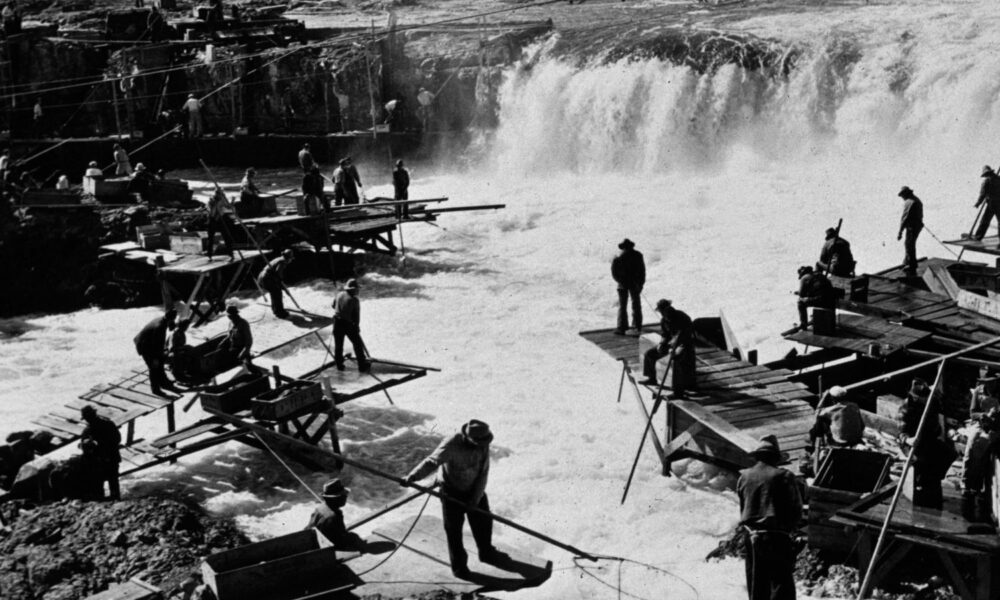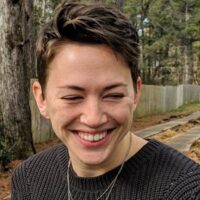Just over a three-hour drive from Seattle, at the confluence of the Yakima and Columbia Rivers in Washington State, a decommissioned Manhattan Project plutonium production facility abuts neighborhoods and homes. Community members in Richland, WA, and surrounding towns have been—and likely still are—exposed to hazardous contamination from the US government’s Hanford nuclear site. They haven’t gotten justice for their suffering, and many people are unaware of the region’s history. My community-engaged health research project aims to help change this, and to get their stories heard.
What is Hanford?
The Hanford nuclear facility was established as part of the Manhattan Project to produce plutonium for nuclear weapons. Plutonium manufactured at Hanford was used in the first atomic bomb, detonated in the Trinity Test in New Mexico, and in the Fat Man bomb detonated over Nagasaki, Japan. During the Cold War, Hanford went on to produce most of the plutonium for the US’s nuclear arsenal.
The facility also generated a tremendous amount of radioactive waste, which was discharged directly into the air, soil, and the Columbia River—before construction of sufficient waste storage tanks. Community members were exposed to radiation through several pathways including breathing airborne particles, ingesting contaminated fish and vegetables, drinking milk from cows that ate contaminated grass, and skin contact with or ingestion of contaminated river or groundwater. There are community concerns about continued exposure and other possible unknown sources of radionuclides and human exposure pathways.
Why community-engaged research?
As a community-engaged epidemiologist, I bring experience and focus on collaborative, social, and environmental justice-oriented research that supports social change. My fellowship project, “Nuclear Weapons, Science, and Equity,” involves analyses of the legacy impacts of the US nuclear weapons industrial complex on health in and around the Hanford nuclear site in Washington State. Community-engaged research is a set of methods that involve impacted community input and participation in the research process, with the intention of disrupting the power imbalance between researchers and impacted community members. It’s my firm belief that any health research should center, and be led by, those most impacted. When it comes to contamination from Hanford, however, those most impacted have been overlooked in the conversation, and/or their perspectives have been silenced.
How did all this come to be? And who was most impacted?
Significance of the land to Tribes
Since time immemorial, Tribal people have lived, fished, gathered and hunted on the lands now commonly known as the Hanford Nuclear Reservation. Under the Treaties of 1855, the Yakama Nation, the Confederated Tribes of the Umatilla Indian Reservation, and the Nez Perce continue to retain specific rights to the lands. The Wanapum Tribe did not sign the treaty ceding their land and therefore were not allocated a reservation. All four Tribes were displaced from the land where they lived and replaced by the Hanford facility, which was established in 1943.
Zooming in, Celilo Falls on the Columbia River (pictured above) was a significant site for Tribal trading and fishing. It was one of the oldest continuously inhabited communities on the continent until it was flooded in 1957 from construction of the Dalles Dam, built to meet the electricity demands of Hanford and other military manufacturing.
Hanford created a segregated company town
The US government acquired Richland, Washington, in 1943 for Hanford workers and their families to support the Manhattan Project work. Workers also settled in nearby Kennewick and Pasco—the three cities forming what is now known as “Tri-Cities.” Kennewick and Richland were “sundown towns,” where non-white people were required to vacate each day by sundown. Pasco housed the smallest number of Hanford workers and was mostly inhabited by farming communities. While Pasco wasn’t a sundown town, Hanford’s estimated 15,000 Black workers, who were occupationally segregated into lower paying and more dangerous jobs, were also residentially segregated into East Pasco.
Releases and cover-ups
There were several documented releases of radioactive materials into the environment during Hanford operations. Some were temporally or geographically bound, such as the Green Run, an intentional release of an estimated 8,000 curies of iodine-131 into the atmosphere on December 2-3, 1949. The Green Run is particularly significant because of its magnitude (for comparison, there were an estimated 15 curies of iodine-131 released in the Three Mile Island accident), its deliberate nature, its proximity and spread to populated areas, and its secrecy. The public did not learn about the Green Run until documentation of it was declassified in 1986, after a years-long campaign by community advocates.
Other intentional and accidental releases also occurred continuously over the past 75+ years. The US Department of Energy estimated that through the year 2000, 227 billion gallons of waste were discharged into the soil in the area around the tank farms and the plutonium reprocessing facilities, including leaks and intentional discharges. The last reactor was decommissioned in 1987.
Insufficient cleanup attempts
In 1989, the Department of Energy entered the “Tri-Party” cleanup agreement with the Environmental Protection Agency and the State of Washington to remediate the site, which is currently estimated to require another 70 years to complete. Known carcinogenic radionuclides, such as plutonium with a half-life of over 20,000 years, are still found on the Hanford site and the surrounding environment, prompting the question: Is it possible to ever truly clean up Hanford?
While the facility is closed, it’s still dangerous. The Columbia River flows through Hanford for over 50 miles, past nine long-since closed nuclear reactors and 177 buried high level nuclear waste tanks holding about 56 million gallons of waste. Today, most of the tanks are decades older than their design life. At least 65 of the waste storage tanks have leaked an estimated total of one million gallons of waste, including radioactive material and other hazardous compounds, into the soil and groundwater.
Research activity left communities without justice
In 1988, Congress mandated a study of the relationship between iodine-131 exposure and thyroid disease among people who lived near Hanford in the 1940s and 1950s. The Fred Hutchinson Cancer Research Center and the Centers for Disease Control and Prevention (CDC) conducted what came to be known as the Hanford Thyroid Disease Study (HTDS)—and concluded that iodine-131 exposure from Hanford did not cause thyroid disease among local residents. This news was devastating and enraging to many community members— like the late Tom Bailie, who gave Spokane-based journalist Karen Dorn Steele the “Death Mile” tour of his neighborhood, in which no house was untouched by illness related to radiation exposure.
A more apt interpretation of the HTDS is that the results were inconclusive. Several experts on radiation and health have written critiques of the HTDS and the Hanford Exposure Dose Reconstruction project, which quantified participants’ estimated level of iodine-131 exposure. In one such critique, prominent researcher Dr. Owen Hoffman and his co-authors published an article detailing many limitations and flaws of the HTDS (including errors in exposure estimation and unfounded assumptions about the nature of these errors), and argued that the findings should not be interpreted as evidence of no impact from Hanford exposures.
A National Academies of Science’s review of the HTDS highlights its failure to acknowledge and account for uncertainty in exposure measurements, lack of clarity in communication of findings to the public, and inadequate statistical power (i.e. ability to detect an effect of radiation exposure) as major barriers to the study’s validity. Beyond that, epidemiological analyses are limited in their ability to detect causal relationships, especially when exposures occurred decades prior to data collection.
Epidemiological methods apply an experimental framework, which ignores historic, social, and political processes that influence who is most exposed. Shoehorning an analytical question like “did radiation exposure from Hanford cause thyroid cancer?” into the experimental framework sets the study up to fail at detecting a relationship, because the social processes make finding appropriate comparison groups and exposure measurement extremely difficult. There is a long history of polluters leveraging these limitations to undermine community organizing and claim lack of impact.
How community-engaged research can help bring recognition and equity
Taking a community-engaged approach to build awareness of the struggles Hanford area residents face gives my UCS collaborators and me the opportunity to expand our methods and validate lived experiences. In conversations with impacted community members and partner organizations, we’ve learned that people want these stories heard. They want more people to know about Hanford and its impacts on downwind communities. They also want acknowledgment from the government of the harms it inflicted. We are working on scientific outputs that are useful to the impacted communities, expanding what “counts” as data, and making it clear that the HTDS isn’t the definitive or final declaration regarding the human health impacts of Hanford’s contamination.
Community members have been leading investigations into exposures from Hanford for decades. For example, Karen Dorn Steele broke the story of the Green Run in the Spokesman Review out of Spokane, Washington. Radiation-exposed individuals like Trisha Pritikin raised concerns about cancer, other illnesses, and infant mortality in their communities. They began to organize and form “Downwinder” groups of people who lived downwind (i.e. in the polluted airway) of the Hanford facility during operations. Many Downwinders were involved in lawsuits against the federal government related to illnesses caused by exposures from Hanford. Karen Dorne Steele covered this litigation, and Trisha Pritikin wrote a book documenting the full stories of several Downwinders called “The Hanford Plaintiffs.” Most of the Hanford plaintiffs received minimal or no compensation from their lawsuits.
Who is a Downwinder?
A foundational component in our community engaged approach is to prioritize relationships over outputs and numbers. This also involves recognizing who is included in and excluded from stakeholder conversations, and moving at the pace set by community members. Because of structural and historical factors like residential and occupational segregation in the Tri-Cities, as well as more complex internal power dynamics, many of the most visible Downwinder activists are white. Some notable partnerships have been forged between impacted Tribal, migrant farmworker, and white communities, in spite of the many barriers to coalition building. However, the Indigenous and non-white perspective is largely absent from the already sparse documentation of Hanford’s health impacts.
Plans for this project
One goal of the fellowship project is to elevate stories from impacted communities that have been previously excluded or overlooked. The idea for this project came from impacted community members, and I seek diverse community engagement with the research process. This looks like: connecting with relevant advocacy organizations, Tribal committees and councils, and local researchers to gauge interest in establishing collaborations and to understand what outputs would be useful to them. If you live in a community in the Hanford region and you’d like to share your experiences and suggestions, please reach out to me at emcclure@ucs.org.
With community voices guiding science, we can more effectively address gaps in data collection and in our collective understanding of impacts. Stay tuned for more progress updates on this project. I will share research questions and processes that we formed in community conversations, such as: Why haven’t more people heard about Hanford, and what was covered up?
The work aims to elevate the stories, experiences, and research of people who have been documenting Hanford’s impacts for decades. The first major output for this project is a comprehensive review of the literature on health impacts of environmental exposures from Hanford. The initial search is underway, but it is already clear that there are major gaps and shortcomings in the existing science on this topic. I expect the power of community-engaged research to help plug these gaps.

